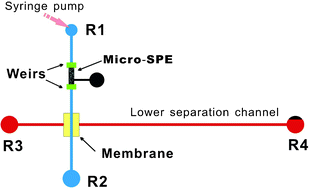Integrated multilayer microfluidic device with a nanoporous membrane interconnect for online coupling of solid-phase extraction to microchip electrophoresis
Abstract
An integrated microfluidic device was developed for online coupling of

* Corresponding authors
a
Dalian Institute of Chemical Physics, Chinese Academy of Sciences, Dalian, P. R. China
E-mail:
bclin@dicp.ac.cn, jhqin@dicp.ac.cn
Fax: +86-84379065
b Graduate School of Chinese Academy of Sciences, Beijing, P. R. China
An integrated microfluidic device was developed for online coupling of

 Please wait while we load your content...
Something went wrong. Try again?
Please wait while we load your content...
Something went wrong. Try again?
Z. Long, Z. Shen, D. Wu, J. Qin and B. Lin, Lab Chip, 2007, 7, 1819 DOI: 10.1039/B711741H
To request permission to reproduce material from this article, please go to the Copyright Clearance Center request page.
If you are an author contributing to an RSC publication, you do not need to request permission provided correct acknowledgement is given.
If you are the author of this article, you do not need to request permission to reproduce figures and diagrams provided correct acknowledgement is given. If you want to reproduce the whole article in a third-party publication (excluding your thesis/dissertation for which permission is not required) please go to the Copyright Clearance Center request page.
Read more about how to correctly acknowledge RSC content.
 Fetching data from CrossRef.
Fetching data from CrossRef.
This may take some time to load.
Loading related content
